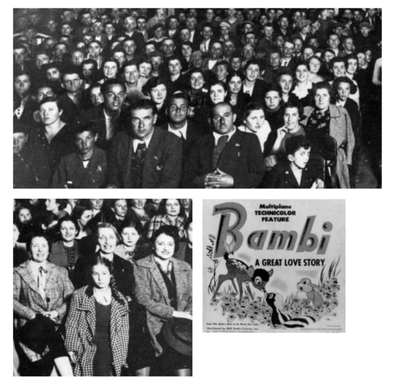Season's Greetings
 In 2024, we wove dreams and built bridges, so that in 2025 we can invite you to the twin city of Nova Gorica and Gorizia, where we will explore cinematic worlds together as part of the European Capital of Culture GO! 2025. Let film be the step that crosses borders and horizons, the pulse that binds different perspectives, or that silence in which the loudest stories are born.
In 2024, we wove dreams and built bridges, so that in 2025 we can invite you to the twin city of Nova Gorica and Gorizia, where we will explore cinematic worlds together as part of the European Capital of Culture GO! 2025. Let film be the step that crosses borders and horizons, the pulse that binds different perspectives, or that silence in which the loudest stories are born.
Happy holidays in the company of your loved ones, and may the new year bring joy!
The Kinoatelje team
On the “Secular” Side of the Holiday
If they were showing Bambi, it was clearly Christmas time.
For instance, fifty years ago, when the posters for Bitter Rice with Silvana Mangano in short black shorts disappeared from the corner walls, and in their place appeared the brightly colored forest of Walt Disney. You can imagine, we kids liked the colorful forest a lot more, and we couldn’t wait for the screening day. But we all had some well-informed aunts who explained to us that it was best not to go to the cinema in the first few days, as it would be too crowded. Better to wait, they said. At Christmas, the cinema was most like a church: even those who never went inside visited it. Whole families, after a long lunch, would rush in and yet miss the beginning, barely finding empty seats right under the screen. Relatives squeezed into their spots, tucked their coats into their laps, stretched their necks, and began to digest together, though with effort.
Christmas was the time when the cinema no longer offered individual pleasure or meetings with peers, but became a space for a shared family event, though some members experienced it with resistance. It was not a time to relive adventures and passions: violence and battles disappeared from the screens. The calendar dictated a return to positive emotions.
 At Christmas, the selection for the discerning typically disappeared, and the atmosphere was unified. All to mass, all to the cinema.
At Christmas, the selection for the discerning typically disappeared, and the atmosphere was unified. All to mass, all to the cinema.
The jewel that shines brightest in this consumerist strategy has been Walt Disney for seventy years: every Christmas a new animated film, already announced with comics, print media, and souvenirs. Bambi arrived on screens in 1949; followed by Pinocchio, Snow White, Dumbo the Elephant, Peter Pan, and other titles, taken from children’s literature from all continents. To top it off, they introduced nature documentaries to the film afternoons, which were excellent in their own right: the series titled The Wonders of Nature, with some of the most famous titles being The Beaver Valley, Living Desert, and The Great Prairie.
For a long time, Italian cinema has been producing a new film each Christmas by the indestructible Vanzina brothers, who are still going strong. The series is of course called Christmas Holidays, with the current year added every year.
Yet many of us still sigh for Walt Disney’s Bambi. Due to waiting for a day when the cinema won’t be crowded, we always missed it.
This essay was written by critic and publicist Sandro Scandolara in the book Our Everyday Cinema. This invaluable work, which will be available for the first time to Slovene readers in early February, during the European Capital of Culture GO! 2025, will be published in a bilingual Slovene-Italian edition. It represents an important contribution to preserving the film heritage and broader cultural memory of the Gorizia area.



